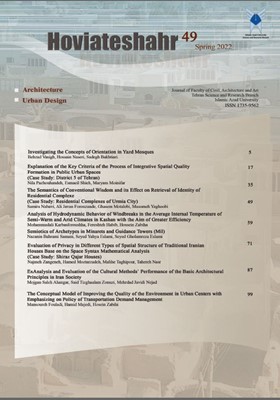The Conceptual Model of Improving the Quality of the Environment in Urban Centers with Emphasizing on Policy of Transportation Demand Management
Subject Areas : urbanismMansoureh Fouladi 1 , Hamid Majedi 2 , Hosein Zabihi 3 , Zahra Sadat Saeideh Zarabadi 4
1 - Ph.D., Department of Urban Development, Science and Research Branch, Islamic Azad University, Tehran, Iran.
2 - Hamid Majedi2, Professor, Department of Urbanism, Science and Research Branch, Islamic Azad University, Tehran, Iran.
3 - Associated Professor, Department of Urban Development, Science and Research Branch, Islamic Azad University, Tehran, Iran.
4 - Associated Professor, Department of Urban Development, Science and Research Branch, Islamic Azad University, Tehran, Iran.
Keywords: Urban Centers, Promoting Environmental Quality, Transportation Demand Management (TDM),
Abstract :
Nowadays in Tehran, one of the most important factors that have reduced the environmental quality of the cities historical, cultural, and tourism centers has been the growing number of private cars in the whole city. Especially in the historic city center, where has led to increasing problems such as traffic jams and environmental pollution, which reduces the vitality and decrease the quality of the environment in the region and ultimately led to a reduction in tourist attraction to this valuable historical area (which has registered more than 177 valuable cultural-historical heritage as world heritage). Has been hence, the organs affiliated with the city's municipal administration have been implementing various traffic policies in this area to reduce their dependence on personal vehicles. In this research, using the exploratory mixed methods research method, five general dimensions for the environmental quality. Using the confirmatory factor analysis method (CFA analysis method), the effect of the policy was identified Traffic (including two punitive policies: car traffic restrictions, parking, and park management, and two incentive policies: pedestrian development and public transport development) on improving the quality of the five dimensions of transport, socio-cultural, infrastructure-Physical, Environmental and Economic center of Tehran Historical Center. The research instrument was a questionnaire, and 378 people were selected based on the Cochran formula. The questionnaire was distributed in the 12th district of Tehran (according to the historical Tehran (Tehran Safavid). The analysis of the questionnaire was done using Lisrel software. The results showed that it was vital to study five environmental qualities, then transport dimension had the most impact, and the socio-cultural dimension had the least one on the traffic policies applied in the study area. The results also indicate that the development of pedestrian development policy and public transportation development has the most effect on the quality of the public space in the historical center of Tehran. Finally, with the use of two winning traffic policies (pedestrian development policy and public transport development), suggestions have been made to improve vitality and the quality (especially in terms of environmental and socio-cultural dimensions) of the study area is given. The results of the present article are vital because of obtaining through quantitative-qualitative, exploratory research methods, field techniques and libraries, analysis of relevant conceptual models, and the instrumental use of a new social marketing approach in issues related to urban communities. Actually, many of the urban problems and the choice of travel behavioral patterns in Iran are based on the beliefs and unfavorable attitudes of citizens towards the environment around their life and city. Changing these behaviors can provide the grounds for solving traffic problems and reducing intra-city car-based travel, and consequently the realization of improving the environmental quality of urban spaces. As a result, to achieve better success in the proposal and executing the plan and for having metropolitan centers with more vitality, the use of citizen participation policy through the application of social marketing techniques, in implementing the transport demand management policies, confirmed as an optimal alternative.
۱. پامیر، سای. (۱۳۹۴). آفرینش مرکز شهری سرزنده اصول طراحی شهری و بازآفرینی. (مصطفی بهزادفر و امیر شکیبامنش، مترجمان). تهران: دانشگاه علم وصنعت، چاپ چهارم.
۲. تیبالدز، فرانسیس. (۱۳۸۷). شهرسازی شهروندگرا: ارتقاء عرصههای همگانی و محیطهای شهری. (محمد احمدینژاد، مترجم). دانشگاه تهران.
۳. جیکوبز، جین. (۱۳۹۲). مرگ و زندگی شهرهای بزرگ آمریکایی. (حمیدرضا پارسی و آرزو افلاطونی، مترجمان). تهران: دانشگاه تهران. (نشر اثر اصلی ۱۹۶۱)
۴. سلطانی، علی. (۱۳۹۰). مباحثی در حملونقل شهری با تأکید بر رویکرد پایداری. شیراز: دانشگاه شیراز.
۵. طرح تفصیلی جدید منطقه ۱۲ تهران. (۱۳۹۱). شهرداری منطقه ۱۲ تهران. تهران.
۶. طرح جامع تهران. (۱۳۸۶). مطالعات حملونقل و ترافیک طرح جامع تهران. تهران.
۷. عدل، شهریار؛ و اورکارد، برنارد. (۱۳۷۵). تهران پایتخت دویست ساله. تهران: سازمان مشاور فنی و مهندسی شهر تهران، انجمن ایرانشناسی فرانسه.
۸. کراکتل، جان ای. (1390). مدیریت ترافیک شهری و مدیریت تقاضا در کشورهای درحال توسعه. (حامد حبیبی، مترجم). تهران: نشر معانی.
۹. گلکار، کوروش. (۱۳۸۰). مولفههای سازنده کیفیت در طراحی شهری. دوفصلنامه علمی-پژوهشی صفه، ۱۱(۳۲)،۳۸-۶۵ .
۱۰. لینچ،کوین. (1381). تئوری شکل شهر. (سید حسین بحرینی، مترجم). تهران: دانشگاه تهران.
۱۱. مرکز آمار ایران. (۱۳۹۵). نتایج سرشماری عمومی نفوس و مسکن ایران. تهران.
Geddes, P., Bromley, R., Iyengar, M. O. T., Geddes, P., Bromley, R., Geddes, P., & Bromley, R. (2018). Concluding Summary. In Town Planning towards City Development: A Report to the Durbar of Indore (pp. 1-4).
_||_


